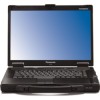Panasonic Toughbook 52 Assessing the Broad Business Case for Rugged Computing - Page 5
technology: the U.S. Armed Services. The MIL-STD-810F standards specify - specifications
 |
View all Panasonic Toughbook 52 manuals
Add to My Manuals
Save this manual to your list of manuals |
Page 5 highlights
Assessing The Broad Business Case For Rugged Computing Some private equipment testing agencies have tested and assessed durable computing products for manufacturers and their customers. The results of these tests, however, are often not released to the public in their entirety - if at all. Thus, manufacturers define their own standards for rugged computing, and additionally, have introduced variations on the concept of rugged. Most manufacturers who claim to build rugged computers have gravitated to a variation of a standards scheme set forth by a leading user of rugged computing technology: the U.S. Armed Services. The MIL-STD-810F standards specify a variety of environmental tests that manufacturers can use to prove that equipment will survive in the field. Of these variables, those that are most relevant to rugged computing include: • Humidity • Contamination by Fluids* • Salt Fog • Sand and Dust* • Icing/Freezing Rain • Explosive Atmosphere (arcing/sparks) • Leakage • High Temperature • Low Temperature • Temperature Shock • Solar Radiation (Sunshine) • Low Pressure (Altitude) • Shock (transport, dropping) • Vibration • Rain* (*On the topic of Ingress Protection, or IP rating, it should be noted that a specific standard has been developed by the International Electrotechnical Commission to classify the degree of protection provided by the enclosures of electrical equipment.) Currently, the Armed Services do not conduct actual tests or certify that rugged devices meet MIL-STD-810F standards. Instead, the Armed Services expect their suppliers of rugged computing equipment to assure or guarantee adherence to the standards. As a result, many rugged computing manufacturers are able to tout their devices as "MIL-STD-810F-compliant" when they meet only one or two of the testing criteria, and even if the device is never offered to or purchased by the Armed Services. Manufacturers often claim partial- or near-compliance with a particular MIL-STD810F testing standard, or otherwise overstate their device's rugged characteristics. This is why it is critical that claims be tested and proven. Copyright © All Rights Reserved for Larstan Business Reports 5














